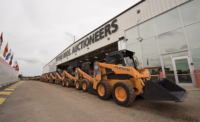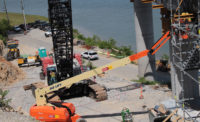In a sign that that U.S. PPE manufacturers are looking to refresh the classic hardhat design, Ergodyne is offering a helmet equipped with the Multidirectional Impact Protection System, an innovation designed to better isolate the brain from the shocks associated with falls and collisions. It is the second U.S. manufacturer to announce a MIPS-equipped construction helmet, after Protective Industrial Products announced a MIPS model of its Dynamic Rocky safety helmet earlier this summer. Ergodyne's helmet is the first to market in the U.S.
The new Ergodyne helmet, marketed under Skullerz brand, uses an isolated inner frame that can move independently of the helmet. This can reduce the rotational energy that can cause brain shear, a condition in which the brain is abruptly rattled around inside the skull due to an impact. This kind of shock is the cause of many traumatic brain injuries, particularly those associated with angled or side impacts to the head.
MIPS is the product of a Swedish-based firm of the same name, which has marketed its technology primarily for biking and mountaineering helmets. Several years ago the company began working with Swedish-based Guardio Safety AB on an industrial and construction-focused version of its helmet. After successful trials with local contractor Södertörn, Guardio brought the helmet to the European market. Robert Österdahl, the health and safety director at Södertörn, was selected as a 2019 ENR Newsmaker.
With MIPS-equipped helmets already being used in Germany, the U.K. and the Nordic countries, versions from companies including Ergodyne and PIP represent a major inroad for the safety technology in the U.S., says Max Strandwitz, CEO of MIPS. “With Ergodyne, we appreciate their investment in this technology without there being an existing U.S. standard [requiring MIPS or similar technology],” he says.
Most hardhats found in the U.S. are designed to prevent head injury due to falling objects, a focus that Strandwitz says doesn’t line up with the broader safety data. “When we looked into the European market, at the safety statistics, we saw that [falling objects] were only 16% of accidents. Fall accidents are closer to 60%.”
Given the available statistics, Strandwitz admits MIPS had a blindspot regarding construction and regrets not getting MIPS into the industrial sectors sooner. “Not much has happened in the last 20 years for [helmet PPE] standards—we’re still just testing against falling objects. We need to be improving standards [to account for] real-life accidents.”
The Ergodyne MIPS helmet meets ANSI/ISEA Z89.1-2014, and it also meets EN12492, the European standard for helmet side impact compliance.
“I came into this industry from the bicycle industry, so I’ve been aware of MIPS for a long time. It’s well established there, you’d be hard-pressed to find a helmet without rotational-energy management or MIPS in it,” explains Tim Gallant, product director for Ergodyne’s protection division. “So when we were able to make the connection with MIPS, we got going right away.”
Aside from the rotation-isolating inner lining, the helmet also features a chin strap, a standard feature of many European construction helmets but a less common sight on American jobsites, even today. Rather than replace existing Ergodyne helmets, Gallant says the company is pursuing a two-tiered strategy for its safety helmet line for now. “What we’re expecting to see in the market is a differentiation between a standard helmet and something with MIPS. There will always be some users saying ‘I just need to meet the current [safety] standard, nothing extra.’ This creates that tiered approach.”
But when it comes to PPE in general, Strandwitz thinks it’s past time for the U.S. to start shifting over to safety helmets with chin straps, MIPS or no. “That chin strap is very important. If you have a fall accident and you don’t have a chin strap on, the helmet will not protect you,” he says.
The Ergodyne models, the Class C Skullerz 8975-MIPS and the Class E Skullerz 8974-MIPS, retail for $96.85 and $88.45, respectively. That is roughly a $15 price premium over the non-MIPS-equipped safety helmets that Ergodyne offers, and Gallant says the lack of significant sticker shock for MIPS will be a bonus. “It’s a pretty easy calculus: is my head worth $15? Probably.”
“What we quickly realized is that we need to educate the industry, but also go directly to the construction companies, talk about advantage of having a MIPS-equipped helmet,” says Strandwitz. “What we have seen in Europe, after having a discussion no one is questioning the price. $15 is not a huge ask.”






Post a comment to this article
Report Abusive Comment